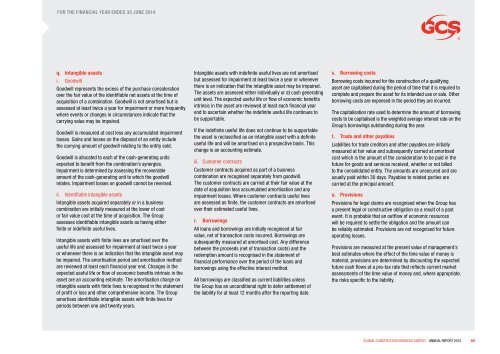GCS ANNUAL REPORT 2014
Create successful ePaper yourself
Turn your PDF publications into a flip-book with our unique Google optimized e-Paper software.
FOR THE FINANCIAL YEAR ENDED 30 JUNE <strong>2014</strong><br />
q. Intangible assets<br />
i. Goodwill<br />
Goodwill represents the excess of the purchase consideration<br />
over the fair value of the identifiable net assets at the time of<br />
acquisition of a combination. Goodwill is not amortised but is<br />
assessed at least twice a year for impairment or more frequently<br />
where events or changes in circumstances indicate that the<br />
carrying value may be impaired.<br />
Goodwill is measured at cost less any accumulated impairment<br />
losses. Gains and losses on the disposal of an entity include<br />
the carrying amount of goodwill relating to the entity sold.<br />
Goodwill is allocated to each of the cash-generating units<br />
expected to benefit from the combination’s synergies.<br />
Impairment is determined by assessing the recoverable<br />
amount of the cash-generating unit to which the goodwill<br />
relates. Impairment losses on goodwill cannot be reversed.<br />
ii. Identifiable intangible assets<br />
Intangible assets acquired separately or in a business<br />
combination are initially measured at the lower of cost<br />
or fair value cost at the time of acquisition. The Group<br />
assesses identifiable intangible assets as having either<br />
finite or indefinite useful lives.<br />
Intangible assets with finite lives are amortised over the<br />
useful life and assessed for impairment at least twice a year<br />
or whenever there is an indication that the intangible asset may<br />
be impaired. The amortisation period and amortisation method<br />
are reviewed at least each financial year end. Changes in the<br />
expected useful life or flow of economic benefits intrinsic in the<br />
asset are an accounting estimate. The amortisation charge on<br />
intangible assets with finite lives is recognised in the statement<br />
of profit or loss and other comprehensive income. The Group<br />
amortises identifiable intangible assets with finite lives for<br />
periods between one and twenty years.<br />
Intangible assets with indefinite useful lives are not amortised<br />
but assessed for impairment at least twice a year or whenever<br />
there is an indication that the intangible asset may be impaired.<br />
The assets are assessed either individually or at cash generating<br />
unit level. The expected useful life or flow of economic benefits<br />
intrinsic in the asset are reviewed at least each financial year<br />
end to ascertain whether the indefinite useful life continues to<br />
be supportable.<br />
If the indefinite useful life does not continue to be supportable<br />
the asset is reclassified as an intangible asset with a definite<br />
useful life and will be amortised on a prospective basis. This<br />
change is an accounting estimate.<br />
iii. Customer contracts<br />
Customer contracts acquired as part of a business<br />
combination are recognised separately from goodwill.<br />
The customer contracts are carried at their fair value at the<br />
date of acquisition less accumulated amortisation and any<br />
impairment losses. Where customer contracts useful lives<br />
are assessed as finite, the customer contracts are amortised<br />
over their estimated useful lives.<br />
r. Borrowings<br />
All loans and borrowings are initially recognised at fair<br />
value, net of transaction costs incurred. Borrowings are<br />
subsequently measured at amortised cost. Any difference<br />
between the proceeds (net of transaction costs) and the<br />
redemption amount is recognised in the statement of<br />
financial performance over the period of the loans and<br />
borrowings using the effective interest method.<br />
All borrowings are classified as current liabilities unless<br />
the Group has an unconditional right to defer settlement of<br />
the liability for at least 12 months after the reporting date.<br />
s. Borrowing costs<br />
Borrowing costs incurred for the construction of a qualifying<br />
asset are capitalised during the period of time that it is required to<br />
complete and prepare the asset for its intended use or sale. Other<br />
borrowing costs are expensed in the period they are incurred.<br />
The capitalisation rate used to determine the amount of borrowing<br />
costs to be capitalised is the weighted average interest rate on the<br />
Group’s borrowings outstanding during the year.<br />
t. Trade and other payables<br />
Liabilities for trade creditors and other payables are initially<br />
measured at fair value and subsequently carried at amortised<br />
cost which is the amount of the consideration to be paid in the<br />
future for goods and services received, whether or not billed<br />
to the consolidated entity. The amounts are unsecured and are<br />
usually paid within 30 days. Payables to related parties are<br />
carried at the principal amount.<br />
u. Provisions<br />
Provisions for legal claims are recognised when the Group has<br />
a present legal or constructive obligation as a result of a past<br />
event. It is probable that an outflow of economic resources<br />
will be required to settle the obligation and the amount can<br />
be reliably estimated. Provisions are not recognised for future<br />
operating losses.<br />
Provisions are measured at the present value of management’s<br />
best estimates where the effect of the time value of money is<br />
material, provisions are determined by discounting the expected<br />
future cash flows at a pre-tax rate that reflects current market<br />
assessments of the time value of money and, where appropriate,<br />
the risks specific to the liability.<br />
GLOBAL CONSTRUCTION SERVICES LIMITED <strong>ANNUAL</strong> <strong>REPORT</strong> <strong>2014</strong><br />
69


